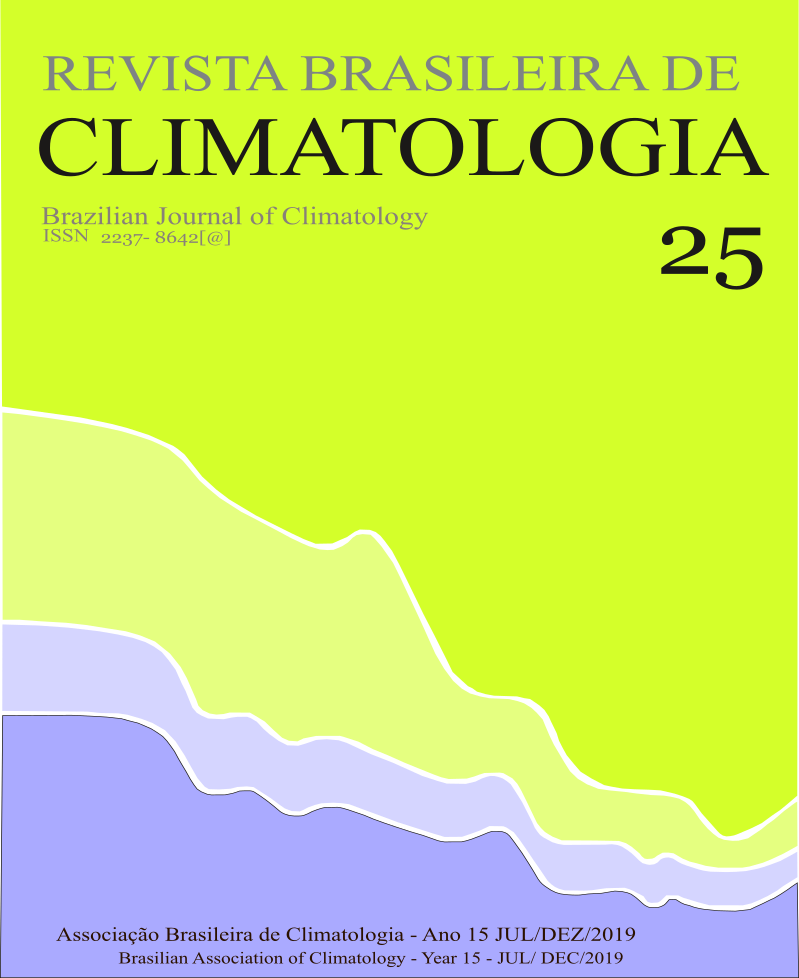SPATIOTEMPORAL VARIATION IN THE PRECIPITATION OF THE AMAZON COASTAL ZONE: USE OF REMOTE SENSING AND MULTIVARIATE ANALYSIS
DOI:
https://doi.org/10.5380/abclima.v25i0.64892Palabras clave:
Precipitation, Coastal, Amazonia, Remote SensingResumen
Reliable data on the spatiotemporal variability in precipitation patterns are vital to the development of effective public policies for environmental management. The analysis of the variation in rainfall rates is currently limited severely by the dependence on data from rain gauges, in particular in regions with a relatively sparsely-distributed network of meteorological stations, as in the Amazon region. The present study investigated the variability in the precipitation and the principal rainfall patterns at different time scales in the coastal zone of the Amazon region, and associated these patterns with the precipitant meteorological systems present in the region. The study was based on the application of remote sensing (CMORPH) data taken at half-hourly intervals on a 0.088 latitude/longitude scale. The spatiotemporal variability in the region’s precipitation was analyzed at different time scales (monthly, seasonal, and annual), with distribution patterns being assessed using a Principal Components Analysis (PCA). The estimates obtained from the CMORPH data provided a satisfactory overview of the precipitation climatology of the study region at the distinct time scales. The PCA identified a precipitation gradient in the two principal pluviometric modes, which together explained 88% of the total variance in the data. The first mode explained 83% of the variance, with two distinct periods, a rainy season and a dry (or less rainy) period, which are influenced by large-scale precipitant systems, the Intertropical Convergence Zone (ITCZ) and High Level Cyclonic Vortices (HLCVs). The second mode, which explains 5% of the variance in the rainfall data, is associated with mesoscale systems that affect primarily the transition periods between the seasons, and depend on the southern extreme of the annual shift in the ITCZ. The understanding of the variation of precipitation patterns using high-resolution CMORPH data, with a comprehensive coverage in both time and space, provides an effective tool for the establishment of public policies at a municipal level, in particular the development of models, and the mediation of the vulnerability of local populations to climatic extremes.Descargas
Descargas
Publicado
Cómo citar
Número
Sección
Licencia
A aprovação dos artigos implica a aceitação imediata e sem ônus de que a Revista Brasileira de Climatologia terá exclusividade na primeira publicação do artigo. Os autores continuarão, não obstante, a deter os direitos autorais. Os autores autorizam também que seus artigos sejam disponibilizados em todos os indexadores aos quais a revista está vinculada.
Os autores mantém seus direitos de publicação sem restrições
A Comissão Editorial não se responsabiliza pelos conceitos ou afirmações expressos nos trabalhos publicados, que são de inteira responsabilidade dos autores.
A Revista Brasileira de Climatologia oferece acesso livre imediato ao seu conteúdo, seguindo o entendimento de que disponibilizar gratuitamente o conhecimento científico ao público proporciona maior democratização do conhecimento e tende a produzir maior impacto dos artigos publicados. Os artigos publicados na revista são disponibilizados segundo a Licença Creative Commons CC-BY-NC 4.0 (https://creativecommons.org/licenses/by-nc/4.0/). Segundo essa licença é permitido acessar, distribuir e reutilizar os artigos para fins não comerciais desde que citados os autores e a fonte. Ao submeter artigos à Revista Brasileira de Climatologia, os autores concordam em tornar seus textos legalmente disponíveis segundo essa licença




